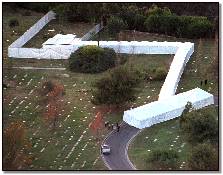Tents shroud walkways and gravesite during re-burial of M. Larry Lawrence in San Diego, California, December 12.

The former U.S. ambassador to Switzerland and chairman of the Hotel del Coronado, who died last year at 69, was the first American to be exhumed from the nation’s most prestigious cemetery under a cloud of suspicion. Honoring his family’s wishes, Arlington officials kept secret the timing of the morning excavation.
A long, winding tent concealed Lawrence’s burial site at El Camino Memorial Park in Mira Mesa yesterday, affording privacy to the small group of mourners who arrived in a convoy of limousines to attend the evening burial. Park security guards aggressively hunted down and evicted reporters and photographers who staked out positions on the cemetery’s grassy slopes.
Lawrence’s remains arrived in San Diego County aboard a private jet that touched down at Palomar Airport in Carlsbad shortly after 4 p.m, according to observers. The burial proceedings were completed about two hours later.
Lawrence’s somber coast-to-coast odyssey came one week after House Republicans first challenged the millionaire businessman’s claim that he served in the merchant marine in World War II and sustained a serious head injury when the cargo vessel Horace Bushnell was torpedoed by a German submarine.
Lawrence told people various versions of the story, but it nevertheless gained him a foreign war medal in an opulent ceremony at the Russian Embassy in 1993. But once the story was challenged last week, it was was quickly revealed to be an audacious lie. Within days, a New York newspaper discovered that Lawrence, then 18, was attending a community college in Chicago in March 1945, when the Bushnell was attacked off the northern coast of Russia.
Another claim from Lawrence’s life — a degree from the University of Arizona — also was revealed as fabrication as government officials and reporters delved into his past.
Ordinarily, Lawrence’s death while serving overseas as an ambassador might have been sufficient to qualify him for an Arlington burial, according to officials. But when he died in January 1996 from complications of leukemia and a blood disorder, Lawrence was granted an exemption to the restrictive rules for burial in Arlington on two grounds: his service as a U.S. ambassador at the time of his death and his purported merchant marine ordeal.
Supporters had noted that the injury Lawrence said he sustained during the torpedo attack would have rated a Purple Heart for a service member.
But the White House sent a clear message last Friday when spokesman Mike McCurry declared that “no one should be buried there who has falsified records.”
After five days of public outrage, during which no military records were found supporting Lawrence, his fourth and final wife, Shelia Davis Lawrence, wrote to President Clinton requesting that her husband’s body be removed because the controversy over his Arlington burial “precludes his resting there in peace.”
Even the tranquil lawns of El Camino Memorial Park may not calm the troubled waters stirred up by Lawrence’s fabrication.
Rep. Terry Everett, R-Ala., who first charged Lawrence with lying, said his House Veterans Affairs oversight subcommittee will continue to investigate the circumstances of Lawrence’s Washington burial. And the State Department is investigating whether it was deceived during its initial background check on the ambassador.
Lawrence was a prolific campaign contributor and fund-raiser, and a friend of the Clintons, and the access that may have provided him both an ambassadorship and an Arlington burial is certain to dog the Clinton administration in future dealings with Congress.
And it was unclear yesterday what would become of the now-infamous Arlington tombstone that included the discredited designation of S1C, the Navy abbreviation for seaman first class, an inscription that came to haunt the man it was intended to honor.
Richard Holbrooke, the former assistant secretary of state who signed the papers that recommended that Lawrence be buried at Arlington, yesterday told The New York Times that Lawrence did a good job in his three years as ambassador before he died.
“He didn’t need to invent parts of his past in order to be respected in the present. It is a tragedy,” Holbrooke said.
Michael Robert Patterson was born in Arlington and is the son of a former officer of the US Army. So it was no wonder that sooner or later his interests drew him to American history and especially to American military history. Many of his articles can be found on renowned portals like the New York Times, Washingtonpost or Wikipedia.
Reviewed by: Michael Howard
